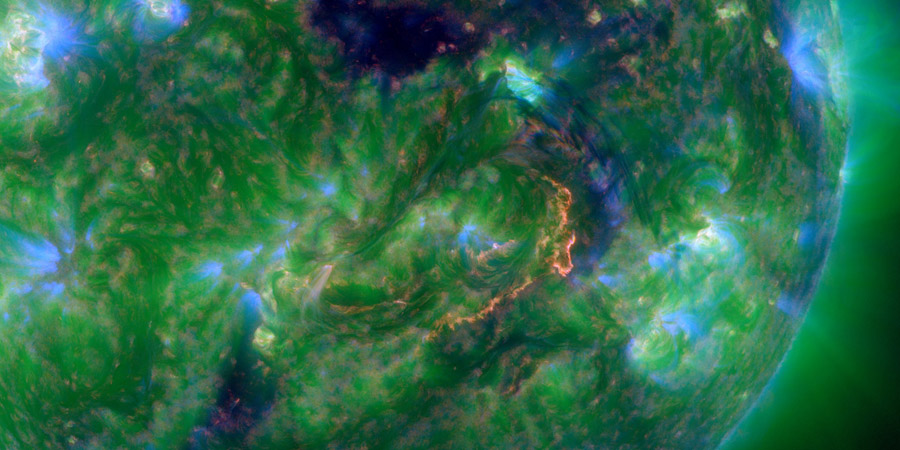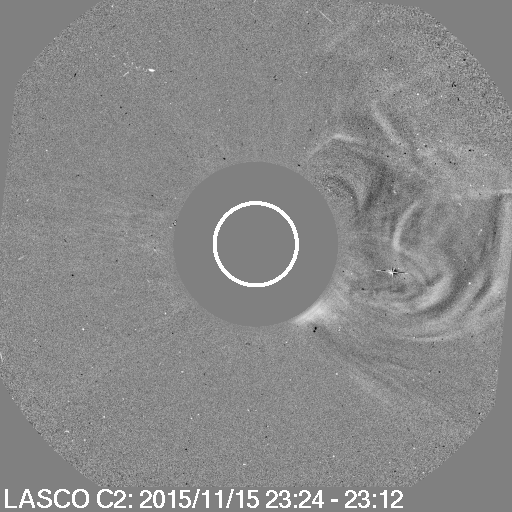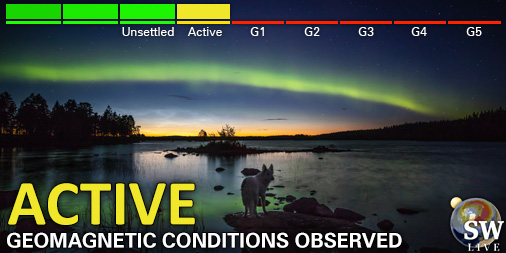Filament eruption, small coronal hole
Monday, 16 November 2015 11:29 UTC

A large filament erupted yesterday close to the center of the earth-facing solar disk. This eruption was quickly followed by a smaller filament eruption near the same location.
Video: Two filament structures can be seen erupting on this video from NASA SDO.
Coronagraph imagery shows us that a majority of the plasma cloud is going SW of Earth. A partial halo coronal mass ejection can be seen but it doesn't even exceed 180 degrees which means that this plasma cloud likely isn't directed towards Earth. We can conclude that this event will likely be a near miss. A glancing blow can not be excluded but the chance for that is low. Based on SOHO imagery we unfortunately have to conclude that us sky watchers shouldn't get our hopes up from this event.

Animation: SOHO/LASCO C2 imagery showing the CME from yesterday's filament eruption.
Small coronal hole faces Earth
A minor coronal hole has been facing Earth the past 24 hours. A solar wind stream flowing from this coronal hole could arrive at Earth in 48 to 96 hours from now. Active (Kp4) geomagnetic conditions are expected at most once the stream arrives.

Image: A small coronal hole faces Earth as seen by NASA SDO.
Thank you for reading this article! Did you have any trouble with the technical terms used in this article? Our help section is the place to be where you can find in-depth articles, a FAQ and a list with common abbreviations. Still puzzled? Just post on our forum where we will help you the best we can!
Current data suggests there is a slight possibility for aurora to appear at the following high latitude regions in the near future
Gillam, MB, Yellowknife, NTLatest news
Latest forum messages
Support SpaceWeatherLive.com!
A lot of people come to SpaceWeatherLive to follow the Sun's activity or if there is aurora to be seen, but with more traffic comes higher server costs. Consider a donation if you enjoy SpaceWeatherLive so we can keep the website online!

Latest alerts
04:15 UTC - Geomagnetic activity
Active geomagnetic conditions (Kp4) Threshold Reached: 03:57 UTC
02:30 UTC - Hemispheric Power Index
The OVATION model predicts the Hemispheric Power Index to reach 50GW at 03:23 UTC
Wednesday, 16 April 2025
21:45 UTC - Geomagnetic activity
Minor G1 geomagnetic storm (Kp5) Threshold Reached: 21:36 UTC
21:00 UTC - Geomagnetic activity
Severe G4 geomagnetic storm (Kp8) Threshold Reached: 20:55 UTC
19:45 UTC - Geomagnetic activity
Strong G3 geomagnetic storm (Kp7) Threshold Reached: 19:25 UTC
Space weather facts
| Last X-flare | 2025/03/28 | X1.1 |
| Last M-flare | 2025/04/15 | M1.2 |
| Last geomagnetic storm | 2025/04/16 | Kp8- (G4) |
| Spotless days | |
|---|---|
| Last spotless day | 2022/06/08 |
| Monthly mean Sunspot Number | |
|---|---|
| March 2025 | 134.2 -20.4 |
| April 2025 | 120.5 -13.7 |
| Last 30 days | 118.3 -22.1 |






